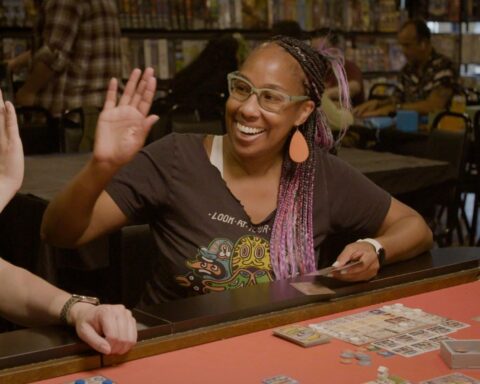“Toronto is probably the most diverse city in the world. Half the population was born outside Canada. People from every country in the world walk these streets. Welcome to the ten blocks of Bloor Street between Crawford and Dufferin.”
So begins The World in Ten Blocks, a new interactive documentary by Marc Serpa Francoeur and Robinder Uppal (a.k.a. Lost Time Media), hosted by The Globe and Mail. Structured as a sort of walking tour of Bloorcourt, the doc profiles a diverse set of the neighbourhood’s small-business owners, with an eye towards their varied experiences of immigration.
Ten Blocks is one of a few recent projects doing this kind of work, in Toronto and elsewhere. Serpa Francoeur cites Katerina Cizek’s multi-part HIGHRISE project as an influence, as well as Hollow, an interactive doc about McDowell County, West Virginia—one of the poorest in America, in the heart of Trump-land. But Ten Blocks’ balance of accessibility and argument, grounded in the care with which it navigates the possibilities and pitfalls of the interactive documentary format—so effectively that one hardly notices it—set it apart.
First off, Serpa Francoeur insists that it’s not a simple portrait of a neighbourhood. For him, the project has always been political. Growing up in Calgary, he tells me, his high school class was split between future ‘oil industry workers’ and people who became “politicized.” A revelatory experience with The Corporation, Mark Achbar and Jennifer Abbott’s classic exposé of corporate malfeasance, set him and Uppal—they’ve been friends since childhood—firmly on the path toward documentary filmmaking. For them, Ten Blocks is about more than just putting a human face on a neighbourhood; it’s about a behind-the-scenes look at the fabric of a uniquely diverse society.
“When we began this project five years ago, we had no idea how much more polarized the issue of immigration would become by the time we finished it,” says Serpa Francoeur. “At present, Canada stands out amongst developed countries in terms of its comparatively inclusive political posture and its relatively successful integration of immigrants. That said, as public attitudes and political climates can change with alarming rapidity, we believe that it is crucial to recognize and celebrate our country’s diversity if we wish to safeguard and augment the inclusivity of our society; The World in Ten Blocks is very much intended to contribute to that effort.”
The doc is not a whitewashing, though. In oblique ways, it’s full of histories of violence, poverty, unrealized dreams and the everyday struggles to make ends meet. The cute couple who run Tierra Azteca, for instance, left Mexico under threats of violence from organized crime; a lawyer and an accountant by training, they are profiled in the doc running a restaurant at Bloor and Dufferin. (They have since moved on to a restaurant on College and shop on Eglinton.) There’s also Mohammed, who spent time in Eritrea, Sudan, and Saudi Arabia before moving to Toronto and opening a falafel restaurant, Empire. There’s Paula of Courense Bakery, whose childhood dream of studying criminology she’s had to forego, passing it down to her niece. And there’s Wire, whose Jamaican grocery store closed in 2013 following the loss of business to nearby Walmart and No Frills.
There’s a personal angle to the interest in immigration. Serpa Francoeur and Uppal are both children of immigrants: Serpa Francoeur’s mother is from the Azores and Uppal’s parents are from Punjab. After growing up in relatively white Calgary, the pair’s meandering twenties brought them first to universities in Calgary and Vancouver, and then abroad. Both spent time in Uppal’s aunt’s home in Punjab where they documented a water-pollution crisis, before Serpa Francoeur went off to Nicaragua, ostensibly to learn Spanish, where he ended up embedding with people affected by a Canadian-owned mine. As his time in Nicaragua was winding up, Serpa Francoeur and Uppal decided to enroll in Ryerson’s Documentary Media graduate programme. Serpa Francoeur tells me that, arriving just days before he was to start at Ryerson, he biked around Toronto looking for a neighbourhood to live in and as soon as he arrived in Bloorcourt he knew he was at home. Soon after, he and Uppal both moved into the neighbourhood and, wanting to use their time at Ryerson to experiment with new forms of documentary media, began developing Ten Blocks.
Uppal even learned to code specifically for this project—“HTML, CSS and JavaScript, to be exact,” he tells me. “[It] has been a fascinating, exciting, and at times, infuriating experience. Luckily, I enjoyed the process enough to stick to it through the rough patches and I have no doubt that my fondness for all things technical was a useful asset in that regard.” Serpa Francoeur adds that, “Without the resources to hire out, we had no choice but to cultivate many skills and manage a workload that would normally be divvied up amongst various specialists. Despite the challenges, we would like to think that our obstinacy has paid off!”
That fact is amazing when watching the final product, which is one of the smoother interactive docs I’ve seen. (Serpa Francoeur insists they’ve been working out kinks throughout the rollout process, but you would hardly know it.) Part of that might have to do with the doc’s formal simplicity. From the user’s perspective, nothing too fancy is going on here—but when you start digging, you find that everything has been done with extraordinary precision.
Each section follows the same two-part format. First, we walk along Bloor St., where a button or two pops up offering more information about the history of this or that building or community—the historical demographics of the neighbourhood, for instance, or the history of the neighbourhood’s theatres and cinemas—before entering a business, to be greeted by the owners. Second, we get a profile of the business owners, with a three- or four-part structure consisting of an introductory video, scrollable photos and facts, a longer video, and sometimes an extra photo album to close it out. Interactivity is limited to the two fundamental internet practices of scrolling and clicking. The walking scenes are guided—you can scroll at your own pace, but you can’t look anywhere they don’t take you. Similarly, you can choose whether or not to divert for more information at particular moments, when buttons show up, not at just any old time.
There’s a brilliance to this simplicity. “We experimented with and prototyped numerous different approaches before choosing the current streetscape and scrolling narrative interfaces,” says Uppal. “We also strove for simplicity in terms of the navigation in order to make the project as accessible as possible to users who are not particularly tech-savvy.” Interactive documentaries—really, interactive art, period—are very new, and people generally don’t have an intuitive grasp of them yet. For the creators of The World in Ten Blocks, this was a major issue they wanted to address. They didn’t want an audience of interactive doc aficionados; they want to reach into the mainstream and into the same communities they document. That led to some deep thinking about the realities of interactivity. Where interactive docs can be confusing, they provide clear choices every step of the way; where people are hesitant to engage with interactive docs because they don’t know what they’re getting into or what kind of time commitment they have to make, Ten Blocks is up front on exactly what is going to happen and how long it will take. The result is a seamless, immersive experience.
Above all, they wanted people to be able to find it. “Creating the work is just one part of the process,” says Uppal. “Actually finding an audience online is perhaps just as daunting, and even the best-conceived and funded efforts sometimes fall short in this area.” To that end, Ten Blocks was first presented on iPads at Hot Docs 2016 and then at Toronto’s Nuit Blanche at one of the restaurants featured in the doc, La Bella Managua. “Given that roughly half of all web traffic is now on mobile devices, we were committed from the outset to delivering on mobile,” says Uppal, “despite the fact that it dramatically increased the level of complexity and posed a whole series of additional programming challenges.”
Ultimately, that desire for an audience led to the partnership with the Globe & Mail. “As independent producers working in the still relatively nascent realm of interactive documentary, we felt that the reach of the project would be greatly increased by a ‘media partner’ who would promote and distribute the project to their established audience.” (To similar ends, both HIGHRISE and Hollow got boosts when they were featured as New York Times Op-Docs.) Adds Serpa Francoeur, “Although the Globe and Mail didn’t fund the project, we think that partnerships like ours between independent creators and established media organizations offer important and as yet largely unrealized opportunities to deliver ambitious, in-depth documentary content beyond the scope of traditional news coverage to mainstream audiences.”
That balance of idealism and pragmatism in the pair’s commitment to making independent, investigative content available to audiences is what sets them apart from high-minded experimentalists on the one hand and mainstream documentarians on the other. Serpa Francoeur confirms that, as much as they were interested in pursuing new media forms for reasons ranging from aesthetics to expediency, The World in Ten Blocks is about the content; all the packaging, from the internal functionality to the partnership with the Globe and Mail, is just a vehicle for the content. The stories are the important part—the part that builds the argument, more important now than ever, that Toronto’s history of immigration is worth protecting and celebrating.










